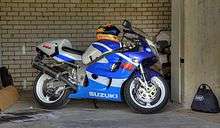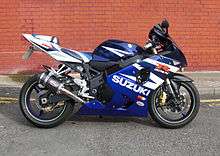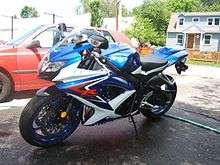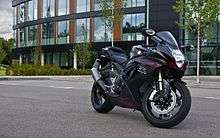Suzuki GSX-R750
 | |
| Manufacturer | Suzuki |
|---|---|
| Also called |
Gixer Gixxer |
| Production | since 1985 |
| Class | Sport bike |
| Related |
Suzuki GSX-R600 Suzuki GSX-R1000 |
Suzuki GSX-R750 is a family of 750 cc sports motorcycles from Suzuki's GSX-R series of motorcycles. Looking like a Suzuki Endurance racer, it can be considered to be the first affordable, modern racer-replica suitable for road use. It was introduced at the Cologne Motorcycle Show in October 1984.[1]
Air and oil cooled
The air and oil cooled models can be divided into the first generation and second generation, colloquially referred to as 'slabbies' and 'slingshots' respectively. The 1985-1987 models featured very flat bodies compared to modern sport-bikes, hence the term 'slab-sided'. The 1988-1991 (1992 USA) models are sometimes referred to as slingshots because the carburetors introduced in 1988 were marketed as slingshot carburetors (slingshot describes the cross section of the semi-flat slide carbs).[2]
GSX-R750 (F) 1985
The original model featured a lightweight aluminum alloy frame, flatslide carbs, twin discs with 4-pot calipers, and 460-millimetre (18 in) tyres both front and rear. To save weight, the designers specified an air-and-oil-cooled engine, rather than a water-cooled engine. The seat has separate front and rear sections but from 1986 onwards all models have a one-piece seat.[3]
GSX-R750 (G) 1986
The 1986 model received a 25 mm longer swing arm to improve the handling. Apart from a modified belly pan and upgraded headlamps there is very little difference between the 1985 and 1986 models. 1986 is the first year the model was introduced to the US.
GSX-R750R 1986
Racing homologation Limited Edition model, limited production. Including a dry clutch system, alloy tank, solo seat rear section bodywork and Limited Edition graphics, as well as the GSX-R 1100's adjustable anti-dive forks.
GSX-R750 (H) 1987
The 1987 model received upgraded 41 mm front forks with NEAS (New Electrically Activated Suspension) from the previous year's RR and a steering damper was fitted as standard. The fuel tank capacity was increased to 21 litres.
GSX-R750 (J) 1988
First major revision. New chassis design, engine revisions and body work. Introduction of a new short-stroke version of the oil-cooled engine, now displacing 748 cc. Engine had 73 mm bore and 44.7 mm stoke and could achieve higher engine speeds (13,000 rpm redline indicated, but rev limiter engaged at 13,500 according to the Suzuki shop manual). Internal engine dimensions changed to accommodate the new bore and stroke. This engine used larger valves and carburetors than previous years. Mikuni model BST36SS 'Slingshot' carbs were 36 mm diameter and featured vacuum operated slides; the slide cross section resembled the shape of a slingshot. A four spring clutch was used on the short stroke motor. New styling, and twin black silencers. Wheels were now a 17-inch (430 mm) diameter, three spoke design and used a 160/60VR17 in the rear and 120/70VR17 in the front. Slingshot graphic first appeared on the bodywork. Forks now used a cartridge design and were 43 mm in diameter. The second generation model was heavier than the first but had a stiffer frame and more power.[4]
GSX-R750 (K) 1989
Minor changes such as: modified lower bodywork, changes to graphics and silver exhaust silencers. Magazines reported that the exhaust manifold now featured small chamfers on the collector for increased ground clearance. Cycle magazines also reported a change to the rear shock mounting geometry and front fork length to improve ground clearance. Graphics/paint schemes varied slightly between global markets. US models were available in blue/white and red/white schemes. The SACS acronym decal, located on the lower body work of the blue/white models, changed from a diagonal lettering to a straight lettering.
GSX-R750R 1989
Limited edition racing homologation model. The redesigned engine reverted to the original long stroke (70 x 48.7 mm) configuration. The crankcase, crankshaft connecting rods and clutch were upgraded to serve as a ready to race platform. The RR also received new 40 mm Slingshot carbs and 4-into-1 exhaust pipe, close-ratio gearbox, braced rear swing arm, single-seat unit and 19 l aluminium fuel tank. Only 150 were sold in US.
GSXR750RK 1989
The GSX-R750RK, also known as the RR, was a limited edition a version first produced in 1989. Out of 500 made, 200 went to Europe and none to the US.
GSX-R750 (L) 1990
Although this model looks very similar to the previous '89 model many changes were made. The 90 model featured changes to the engine, suspension, body work, brakes and chassis. This was the first GSX-R to be fitted with inverted forks as standard (USA models retained the conventional forks until 1991), and returned to the bore and stroke of the original long-stroke engine.
The engine returned to the 749 cc engine bore and stroke dimensions of the original long-stroke engine but still maintained the 13,000 rpm redline. It now featured mm valve (smaller than the 88-89 short stroke but larger than the 85-87) and used larger carburetors.
The new Mikuni model BST38SS carburetors were 38 mm diameter and featured an additional "Powerjet" high-speed circuit that was used to fine tune fuel mixture from 10,000 rpm to the rev limiter. In the unrestricted USA bikes, the Powerjet circuit was jetted with a "zero" sized jet and activating the circuit simply required replacing the "zero" jet with a #57.5 to #62.5 jet. All other worldwide bikes with the 38 mm carbs came equipped with a functioning Powerjet circuit. The slide breathers were now divorced from air box.
The exhaust system was also changed, gone were the dual silencers and replaced with one stainless steel silencer on the right side. The transmission output shaft was lengthened to accommodate a wider wheel. A new curved oil-cooler design and oil lines (attached to the oil pan similar to the original 85-87 engines) were installed.
The frame was changed for 1990 and used some of the features from the 1989 GSX-R 1100 frame. The rake was now 25.5 degrees and wheelbase 55.7 inches (1,410 mm). The front suspension now had inverted forks, the triple clamps (yokes) and handlebars were changed to accommodate the new forks. The rear suspension featured a new damper (shock) and swingarm. The rear damper (shock) now had a remote reservoir and damping adjustment. The revised swingarm now featured cast ends for the axle adjustment. The rear wheel was widened to 5.5 inches (140 mm) (previously 4.5 inches (110 mm)) but the tire size remained the same. A non-adjustable steering damper was added which attached from the left frame rail to a clamp on the left fork (US models did not receive the damper but the frame had the tapped mounting holes). The rear sprocket carrier and sprocket changed to a six-bolt design (previously five). The front brake rotors changed to a slotted design (previously cross drilled holes).
The body work changed slightly also. The side vents became less rectangular and in a slightly different position. Anew fender was also used with the inverted forks (except US).
GSX-R750 (M) 1991
The '91 GSX-R750M gained 15 kg over the previous model. The most notable feature of the "M" are the faired in headlamps and a slanted nose, both of which were designed to reduce drag. Also fitted was a new larger seat and new rear body work that featured twin tail lamps. This was the last GSX-R to use the oil-cooled SACS engine (except for US). Internal engine changes included a new valvetrain that used one dedicated cam lobe and rocker arm (finger follower) per valve (previous models used one lobe and one forked rocker per two valves). Valve clearance (lash) was now adjusted with shims (previous models used a screw and nut). The cam duration and indexing changed slightly as well as the porting according to a magazine article. The rear tyre width was increased to a 170 mm section width. The gauges also changed to white coloured needles (previously amber coloured).
GSX-R750 (N) 1992
1992 US models are the same as the 1991 with different paint and graphics. All other markets got the new water-cooled GSX-R 750.
Water-cooled
GSX-R750 (WN) 1992
New water-cooled engine and revised frame, bodywork and suspension. USA market models retained the oil-cooled engine and the USA 1992 model is basically the same as the 91 model with different graphics. A sleeved down version was available as the GSXR-600 for 92 and 93, both years were available with inverted forks. Interestingly, the 1992 GSXR-600 was water-cooled for the US market while the 750 had to wait one more year.[5]
GSX-R750 (WP) 1993
Mostly cosmetic changes, major revision of engine internals, the crank & connecting rods were forged steel instead of cast iron. Valve-train was revised as well which allowed for a significant increase in power.
GSX-R750 (WR) 1994
Reduced power and weight on last years model. The inverted forks for this year were blue annodized.
GSX-R750 SPR 1994-1995
The 'SPR' limited-edition racing homologation model has special factory parts including wide-mouthed TRM40 carbs, close-ratio gearbox, magnesium engine covers, alloy water pump, six-piston brake calipers, and a new braced swingarm. A wider rear wheel holding a wider 180 rear section tyre was also fitted. The 'SPR' was 10 kilos lighter than the WP.
GSX-R750 (WS) 1995
Last model to use the double-cradle for more stiffness over the 94 model year and the top fairing was all new with lighter, twin reflector beam headlights. Touted by Motorcyclist as having the most ground clearance leant over, just behind a Ducati 916.
SRAD
The SRAD (Suzuki Ram Air Direct) provides air intakes at the front that force air directly into the airbox. All models as of 1996 have employed this design.
GSX-R750 (T) 1996
The 1996 GSX-R introduced a new twin-spar frame which was derived from Suzuki's RGV 500 GP racer. A new compact and lightweight engine incorporated magnesium covers on the cylinder head, starter motor and clutch cover to aid weight reduction. These changes resulted in a decrease in weight by 20 kg to 179 kg, while power had increased to a 118 hp (88 kW). This year's model finally addressed the weight problems that had plagued the GSX-R through the first half of the 90s.[6]
Other features included electronically controlled "main jet block off under decel" system (for emissions purposes) 38mm Mikuni carburetors and 43 mm inverted forks which were fully adjustable. Also a 17in rear rim was fitted as standard with a 190/50-17 size tire as fitted to all models from 1996 to 1999.
GSX-R750 (V) 1997
Minor internal tweaks on the 1996 model, improved aerodynamics.
GSX-R750 (W) 1998
Introduction of electronic fuel injection. Gain in power to 134 bhp.
GSX-R750 (X) 1999

Only minor modifications were carried out on the 1999 model consisting of new graphics and a few internal tweaks. The 1999 Model year GSX-R won the sport bike of the year award and produced 134 Crank Horsepower for the final year of the SRAD design.
GSX-R750 Y 2000
All New Model covering 2000 through 2003 -Lighter Stronger Faster: Sometimes called superman bike because of headlight shape.
Engine: Much smaller yet stronger motor, upgraded fuel injection with improved fueling correction for barometric pressure / altitude, redesigned narrower cylinder head with straighter intake tracts, bigger air box, better ram air, stainless steel 4 into 1 exhaust, lighter stronger engine components and covers, increased cooling capacity.[7]
Body: More aerodynamic bodywork, smaller frontal area, redesigned instrument cluster, new LCD information (odometer, coolant temperature, clock).
Frame: New re-designed twin spar frame, extended swingarm, lighter front brakes to reduce un-sprung mass, lighter cast wheels to reduce rotating mass.[7]
GSX-R750 K1 2001
Transmission had a number of parts changed due to design defect that caused 2nd gear to slip and cause transmission failures. The input shaft and a number of other parts were upgraded and an internal service bulletin issued by Suzuki to its dealerships.
GSX-R750 K2 2002
Few minor tweaks for 2002: Changes to the EFI, new adjustable swingarm, new mirrors, and new fully brushed exhaust.
GSX-R750 K3 2003
Colours changed. First year that bikes have lights on 24 hrs (UK). Redesign year (Not UK).
GSX-R750 K4 2004
Refined version of the 00-03 model years. ECU now 32 bit, from 16 bit,[8] titanium valves, new body work, black powdercoated frame and swingarm, and 4-piston radially mounted Tokico brakes.[9]

The engine produced 147 hp (110 kW) claimed power at crank shaft; 127.3 hp (94.9 kW) at 12,750 rpm rear wheel hp tested by bike magazine on uncertified dynamometer,[8] and torque of 79 N.m (58.2 ft.lbf) @ 10,750 rpm.[8] Redline was 14,500 rpm.[10]
Dry weight was just 163 kg (359 lb) [9] making it one of the lightest GSX-R's ever produced.
GSX-R750 K5 2005
Besides changing colour on the motorcycle, Suzuki celebrated their 20th anniversary by launching the Suzuki 20th Anniversary GSX-R 750, which included custom paint, custom exhaust and sunex brake rotors.... EL blue chain, blue seat and 20th anniversary placards.
GSX-R750 K6, K7 2006-2007
Redesign year. New frame and swingarm and motor. Stroke increased and transmission is now stacked. Rotors also went from 300 mm to 310 mm. Modifications compared to previous model include all new compact and lightweight 4-stroke, 4-cylinder, liquid-cooled engine designed for overall weight reduction, optimum combustion efficiency and power delivery Re-designed cylinder head with narrower valve angles creating a more compact combustion chamber design, higher 12.5:1 compression ratio, large intake and exhaust ports for improved intake and exhaust efficiency and high power output Valve bucket diameters are increased to work with more aggressive camshafts Lightweight titanium valves with steel alloy springs and aluminum spring retainers operated by thin-wall hollow camshafts to reduce weight and inertia
GSX-R750 K8, K9, L0 2008-2010

New model - revised headlights, new colors, multi-mode power adjustments. At the rear wheels, the engine produces 123 hp (92 kW) at 12,500 rpm,[11] and torque of 53.4 lbf·ft (72.4 N·m) @ 11,200 rpm.[11] The dry weight is 394 lb (179 kg).[11]
GSX-R750 (L1-L6) 2011-2016

Currently the longest ever produced GSX-R 750 series without any major changes. New model, clean and sleek body style, new headlight, addition of Italian made Brembo brake calipers (front) and Nissin (back).[12] The 2011 model is about 9 kilograms (20 lb) lighter than the previous year's model. It has a "back torque limiting" clutch that allows for slicker downshifting. A lightweight Showa Big Piston Fork (BPF)[13] comes standard along with a Showa rear shock. Features a more compacted instrument panel which was inspired by the GSX-R1000 instrument panel. The engine power produced at the rear wheel is 127.9 hp (95.4 kW)@ 12,600 rpm.[14]Torque at the rear wheel is 55.7 lbf·ft (75.5 N·m) @ 11,100 rpm.[14] Wet Weight is 194.1 kg (428 lb).[14]
References
- ↑ Pole, Warren (22 April 2008). "Road Test: Suzuki GSX-R750 History - Road Tests - Visordown". Visordown. Immediate Media Company. Retrieved 19 January 2015.
Suzuki's GSX-R750 snapped up the TWO Bike Of The Year Award 2004 last month. To mark the occasion, we celebrate 20 years of three-quarter litre lunacy with every generation of GSX-R 750
- ↑ "Gsx R 750 M 1991". www.gsxr-suzuki.it. Retrieved 12 January 2015.
The Suzuki 1991 Gsx R 750 M breathes through Slingshot smoothbore carbs featuring a unique slide design developed by Suzuki engineers working with Mikuni technicians. The design combines the best performance features of a flat slide and a round slide, delivering the quick response and reduced throttle-movement resistance of a flat slide and the less-turbulent airflow and better sealing of a round slide.
- ↑ Pole, Warren (22 April 2008). "Road Test: Suzuki GSX-R750 History - Generation 1 GSX-R750F, G & H review". Visordown. Immediate Media Company. Retrieved 19 January 2015.
- ↑ Pole, Warren (22 April 2008). "Road Test: Suzuki GSX-R750 History - Generation 2 GSX-R750J, K, L & M review". Visordown. Immediate Media Company. Retrieved 19 January 2015.
- ↑ Pole, Warren (22 April 2008). "Road Test: Suzuki GSX-R750 History - Generation 3 GSX-R750WN, WP, WR & WS review". Visordown. Immediate Media Company. Retrieved 19 January 2015.
- ↑ Pole, Warren (22 April 2008). "Road Test: Suzuki GSX-R750 History - Generation 4 GSX-R750WT, WV, WW & WX review". Visordown. Immediate Media Company. Retrieved 19 January 2015.
- 1 2 Pole, Warren (22 April 2008). "Road Test: Suzuki GSX-R750 History - Generation 5 GSX-R750Y review". Visordown. Immediate Media Company. Retrieved 19 January 2015.
- 1 2 3 "2004 Suzuki GSX-R750 Motorcycle Test", Motorcyclist Online
- 1 2 Suzuki GSX-R Road Test (PDF)
- ↑ Pole, Warren (22 April 2008). "Road Test: Suzuki GSX-R750 History - Generation 6 GSX-R750 K4 review". Visordown. Immediate Media Company. Retrieved 19 January 2015.
- 1 2 3 "Suzuki GSX-R750 – Middleweight Motorcycles", Cycleworld
- ↑ "2011 Suzuki GSX-R 750 | Street Test", UltimateMotorCycling
- ↑ Ash, Kevin (2010), "Big Piston Forks", Ash on Bikes, retrieved March 11, 2012 Originally published in the Motor Cycle News Tech Watch column
- 1 2 3 "Sportbike Weights and Measurements". Sport Rider. August 23, 2011. Retrieved June 24, 2016.
External links
| Wikimedia Commons has media related to Suzuki GSX-R 750. |